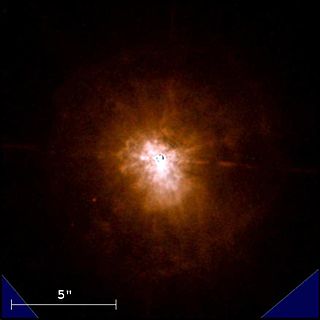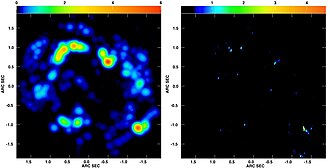IRC + 10420
|
Star IRC + 10420 |
|||||||
|---|---|---|---|---|---|---|---|

|
|||||||
| Image of IRC + 10420 and its surrounding dust disc | |||||||
| AladinLite | |||||||
|
Observation dates equinox : J2000.0 , epoch : J2000.0 |
|||||||
| Constellation | Eagle | ||||||
| Right ascension | 19 h 26 m 48.1 s | ||||||
| declination | + 11 ° 21 ′ 16.8 ″ | ||||||
| Apparent brightness | 11.66 likes | ||||||
| Typing | |||||||
| B − V color index | (2.32) | ||||||
| Spectral class | F8 I to G0 I. | ||||||
| Astrometry | |||||||
| parallax | (0.58 ± 0.16) mas | ||||||
| distance | (5500 +2500−1500) Ly (1,700) pc |
||||||
| Proper movement | |||||||
| Rec. Share: | (−2.04 ± 0.22) mas / a | ||||||
| Dec. portion: | (−7.41 ± 0.19) mas / a | ||||||
| Physical Properties | |||||||
| Dimensions | (6) M ☉ | ||||||
| Luminosity |
(600000) L ☉ |
||||||
|
Other names and catalog entries |
|||||||
|
|||||||
IRC + 10420 , also known as V1302 Aquilae, is a yellow hypergiant in the constellation of Eagle . It has been assumed that the star is about 4-6 kiloparsecs away from our Sun , with more recent data from the Gaia mission pointing to a shorter distance of less than 2 kiloparsecs.
discovery
IRC + 10420 was first discovered in 1969 and listed in the " Infrared Catalog of 2.2 micron sources ". It was noticed very early on that it was an unusual star, as it is one of the brightest objects in the sky with 20 microns and an additional infrared excess . He has been compared to Eta Carinae during the time of her outbreak. It was also discovered that it was a potent source of hydroxyl radical - maser emissions. Some authors and researchers assigned IRC + 10420 to the protoplanetary nebulae due to the surrounding nebulae, but the prevailing opinion was that it was a very bright supergiant.
Physical Properties
Although it is one of the brightest stars in the sky, approx. 500,000 times brighter than the sun, due to the great distance it cannot be observed without telescopes . Its spectrum has changed from an “F” to an “A” over the last few decades without losing its brightness. From this it is concluded that it is an earlier red supergiant which turns bluish on the Hertzsprung-Russell diagram and changes to a bright blue variable , a Wolf-Rayet star or a pre- supernova . It is assumed that it began its star life with 40-50 times the solar mass, but then lost so much mass due to strong stellar winds that it shrank to about 10 times the solar mass and was completely surrounded by matter, which was initially due to a false photosphere its extremely high temperature. What can be seen now is not the star itself, but the gas emitted by the star.
Surrounding fog
IRC + 10420 is surrounded by a reflection nebula 30-40 times the mass of the Sun ejected from the star. The nebula was examined with the Hubble Space Telescope , which revealed complicated structures such as arcs, rays and condensation, comparable to the nebula of the red hypergiant VY Canis Majoris .
Individual evidence
- ↑ a b c d e IRC +10420. In: SIMBAD . Center de Données astronomiques de Strasbourg , accessed September 9, 2018 .
- ↑ V1302 Aql. In: VSX. AAVSO, accessed September 9, 2018 .
- ^ A b H. Nieuwenhuijzen, C. De Jager: Checking the yellow evolutionary void. Three evolutionary critical hypergiants: HD 33579, HR 8752 & IRC +10420 . In: Astronomy and Astrophysics . 353, 2000, p. 163. bibcode : 2000A & A ... 353..163N .
- ^ E. De Beck, L. Decin, A. De Koter, K. Justtanont, T. Verhoelst, F. Kemper, KM Menten: Probing the mass-loss history of AGB and red supergiant stars from CO rotational line profiles. II. CO line survey of evolved stars: Derivation of mass-loss rate formulas . In: Astronomy and Astrophysics . 523, 2010, p. A18. arxiv : 1008.1083 . bibcode : 2010A & A ... 523A..18D . doi : 10.1051 / 0004-6361 / 200913771 .
- ↑ BV Kukarkin, PN Kholopov, NP Kukarkina: 61st Name-List of Variable Stars . In: Information Bulletin on Variable Stars . tape 1068 , 1975, pp. 1 , bibcode : 1975IBVS.1068 .... 1K .
- ↑ Gaia DR2 in VizieR. Retrieved September 9, 2018 .
- ^ G. Neugebauer, RB Leighton: Two-micron sky survey. A preliminary catalog . In: Nasa Sp . 1969, bibcode : 1969IRC ... C ...... 0N .
- ↑ Identification on historical photographic plates showed possible irregular variations of about a magnitude before 1925, followed by a smooth gradual increase in brightness from magnitude 15 to brighter than magnitude 14 by 1976.
- ^ PT Giguere, NJ Woolf, JC Webber: IRC +10 420 - A hot supergiant maser . In: Astrophysical Journal . tape 207 , 1976, pp. L195 , doi : 10.1086 / 182211 , bibcode : 1976ApJ ... 207L.195G .
- ^ EW Gottlieb, W. Liller: Photometric histories of six infrared objects and three highly reddened blue supergiants . In: Astrophysical Journal . tape 225 , 1978, pp. 488 , doi : 10.1086 / 156509 , bibcode : 1978ApJ ... 225..488G .
- ↑ Terry Jay Jones, Roberta M. Humphreys, Robert D. Gehrz, Geoffrey F. Lawrence, Franz-Josef Zickgraf, Harvey Moseley, Sean Casey, William J. Glaccum, Carol J. Koch, Robert Pina, Barbara Jones, Kim Venn, Otmar Stahl, Sumner G. Starrfield: IRC +10420 - A cool hypergiant near the top of the HR diagram . In: Astrophysical Journal . tape 411 , 1993, pp. 323 , doi : 10.1086 / 172832 , bibcode : 1993ApJ ... 411..323J .
